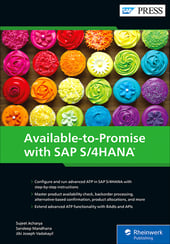This blog post will explore how standard product segmentation, when combined with SAP S/4HANA for advanced ATP, can assist in navigating tariff implications.
This topic is particularly relevant today, as many industries are facing challenges during their transformation journeys. By integrating the strategies outlined in this post, businesses can better navigate the SAP S/4HANA architecture framework for order commitment.
Product Segmentation with Country of Origin
In the SAP environment, product segmentation serves as an essential strategy for categorizing materials or products according to various specific attributes, such as color, size, quality, and other distinguishing features.
This systematic approach facilitates the effective management of both demand and supply, allowing organizations to assign product supply to requirements based on established segmentation rules. Such a method minimizes the necessity of creating separate material master data for each individual segmentation value, leading to greater efficiency in inventory management.
A crucial aspect of managing tariffs involves understanding the country of origin (COO) for the product. This information is readily available within batches during the manufacturing process. I strongly encourage the use of COO as a central criterion for product segmentation. By leveraging the country of origin, businesses can more precisely define rules that govern the interplay between demand and supply.
Any organization's initial step is to utilize the COO to outline these rules effectively. Each organization faces its unique set of tariff implications; for instance, specific products manufactured in certain countries may incur higher tariffs when exported to certain destinations.
Such tariff regulations are typically influenced by the dynamics of demand and supply, including the source of supply and the target market for demand. Adapting product segmentation strategies to align with these tariffs can provide a competitive advantage in navigating complex trade landscapes.
Segmentation Strategy
The segmentation strategy plays a crucial role in determining how different requirement segments are allocated to stock segments during the available-to-promise (ATP) process. This allocation is essential for ensuring that supply is effectively matched with demand, particularly in international supply chain scenarios.
Creating a robust segmentation strategy involves establishing a set of clear rules regarding the country of origin for the products being supplied. These rules dictate that the origin of the supply must be directly linked to the demand in the destination country. For example, if a product is produced in Country A, it should primarily fulfill demand that is generated from Country B. This linkage ensures a more efficient flow of goods and minimizes the risk of stockouts in the target markets.
Once these fundamental rules are articulated, the next critical step is to implement them effectively during the sales order processing phase. The established segmentation rules serve as the foundation for order commitments, meaning that they guide how and where supply can be allocated based on current demand.
For instance, if the demand arises from Country B, only those supplies that originated in Country A will be considered for order fulfillment.
In scenarios where a single country does not provide enough supply options, the strategy can be broadened. Rules can be defined to allow the commitment of supplies sourced from a combination of countries (which we refer to as COO-S) to meet the demand from a specified set of countries (designated as COO-D).
This flexibility is vital for adapting to fluctuating market conditions and ensuring that customer needs are met in a timely manner, regardless of the geographical complexities involved.
The following illustrations demonstrate how we can effectively map demand and supply segments within our framework. In this context, DG1 represents the demand generated by various countries, while SG signifies the supply available from these nations. This mapping can account for both specific requirements from individual countries and aggregated demands from groups of countries.
Moreover, this system is flexible; certain demand profiles can be met by any combination of countries, particularly in cases where tariff implications are minimal or nonexistent.
It's important to note that these demand and supply characteristics are integrated within the SAP system. By assigning these characteristics to the relevant master data and transactional elements, we are able to create a fully executable product segmentation framework that facilitates efficient order processing. This structure enables us to respond to market demands more effectively while adhering to logistical and regulatory considerations.

To effectively implement segmentation for materials, it is essential to activate the segmentation feature by configuring the appropriate segmentation strategy within the material master data. This process allows for the categorization of materials into distinct segments, facilitating better management and analysis of inventory.
The following illustration provides a detailed guide on how to assign the segmentation strategy to a material master record, ensuring that the material is identified as a segmented material. By doing so, organizations can enhance their material tracking and reporting capabilities, ultimately leading to improved operational efficiency and decision making.

Once the materials are segmented, it is essential to assign every transaction in SAP related to that material to either the requirement segment or the stock segment, depending on the nature of the transaction.
For instance, when materials are produced and moved into inventory, the system will assign the stock segment to those transactions. Conversely, when a sales order is created, it signifies a demand for that material, prompting the assignment of the requirement segment.
To streamline this process of associating the correct segment with various stock and requirement transactions, SAP has implemented standard transactions that can automatically default to either a requirement or stock segment during the transaction.
This functionality allows users to define specific rules—for example, assigning a particular requirement segment based on the sales order type, distribution channel, or geographical region, as illustrated via DG1 in our previous example.
The screenshots below demonstrate the default settings screen, where users can establish various guidelines for automatically assigning a specific requirement or stock segment. This process is fundamental as it forms the baseline for how every transaction, including demand and supply elements along with inventory, is categorized or assigned to designated segments on both the demand and supply sides.
Furthermore, these default rules can be expanded and customized further when the standard rules do not sufficiently cover all necessary default segment assignments in the demand and supply transaction data. This flexibility ensures that organizations can adapt their SAP configurations to meet unique operational requirements and maintain consistency in their transaction processing.

Once all the supply components, such as inventory levels, production orders, planned orders, and purchase orders, have been categorized appropriately to indicate their origin—specifically whether they come from Country A or Country B, or in our context, SG1 or SG2—it's time to align the demand components.
The demand elements, exemplified by sales orders, should be assigned a requirement segment, designating them as either DG1 or DG2. With these classifications firmly in place, the next step involves employing an advanced ATP algorithm. This algorithm will analyze the categorized supply and demand data to make precise commitments, ensuring that customer needs are met efficiently based on the assigned segments.
Advanced ATP in SAP
SAP S/4HANA for advanced ATP (aATP) is an essential business functionality within SAP S/4HANA that plays a crucial role in addressing order fulfillment requests in both sales and production planning. An order fulfillment request is defined by several key elements: the specific material required, the plant from which it will be sourced, the quantity that is being requested, and the date when the material is expected to be available.
The response generated for these requests takes into account the current inventory levels, any anticipated stock receipts in the future, and also considers concurrent orders that may impact availability.
Moreover, the aATP process can incorporate various additional restrictions influenced by other order attributes, such as customer specifications or geographical regions. This allows for a more tailored and accurate confirmation proposal. The ATP function generates detailed confirmation proposals for the requested material and plant, indicating not only the quantities that can be confirmed but also the exact dates on which these quantities will be available.
The aATP algorithm is particularly effective as it evaluates alternate substitutes—whether they involve different materials or plants—within a constrained supply environment.
The algorithm operates under the parameters of Advanced Business Connector (ABC) rules, product allocation, and various other capabilities of aATP, such as supply protection mechanisms.
If segmentation is active and materials are appropriately segmented according to the established segmentation strategy or pool segments, aATP will take into account both supply segments and demand segments during its availability checks.
For example, if a sales order originates from a demand segment labeled DG-1, the system will only confirm the order based on the ATP quantities available from the supply segment SG-1. Notably, any supplies that belong to a segment other than SG-1 will not be considered, thereby ensuring that order commitments strictly adhere to the specific requirements of customer demand and the relevant stock segments.
This highly selective process ensures that customer demands are met in a precise and contextual manner, reflecting the true availability of stock based on defined segmentation criteria.
Conclusion
Leveraging SAP's core functionalities during an enterprise transformation can significantly benefit any organization. By implementing the strategies outlined previously, particularly through the use of product segmentation within SAP ATP, businesses can enhance their operations.
This approach not only streamlines the management of inventory and order promises but also aids in navigating complex tariff implications more effectively. As a result, organizations can provide more accurate customer commitments and improve overall satisfaction by ensuring timely and reliable deliveries.
Learn aATP in Our Upcoming Rheinwerk Course!
Optimize supply chain responsiveness with “Advanced ATP with SAP S/4HANA.” This comprehensive course covers advanced ATP setup and the functionalities that support real-time availability checks to meet customer expectations. After exploring foundational architecture, dig into the essential aATP solutions to see how SAP S/4HANA solves modern demand-supply challenges. This upcoming course is live on the web and will teach you all you need to know about these topics. Click on the banner below to learn more and order your ticket.
This post was originally published 5/2025.





Comments